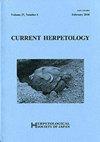Selective Oviposition by Oriental Fire-bellied Toads in Temporally Fluctuating Environments
IF 0.7
4区 生物学
Q4 ZOOLOGY
引用次数: 1
Abstract
Abstract: Selective oviposition is widespread in anurans because it significantly affects the survivorship of their offspring, especially when environmental conditions are heterogeneous and potentially unfavorable. In the present study, we aimed to determine whether female oriental fire-bellied toads (Bombina orientalis) selectively lay eggs to increase their progeny's survival. We studied the Jeju Island population because the streams on this island are ephemeral, so the timing and site of egg-laying can be important for the survival of their progeny. We surveyed all pools in a specific area of an ephemeral stream for two years to determine whether female B. orientalis selectively lay eggs in certain pools to increase their progeny's survival. The characteristics of pools in our study sites varied especially in size that ranged from 0.01 to 36 m2 in surface area. We found that female B. orientalis avoid laying eggs in very small pools where the risk of desiccation or over-heating of water is high. However, unexpectedly, they also avoided large pools and primarily laid eggs in the pools that are not very small or large. In terms of timing, egg-laying took place in association with the timing of rain: the number of pools with egg clutches decreased as the number of days since the last rainfall increased. Females also avoided laying eggs in pools that were already occupied by tadpoles. Field experiments demonstrated that the degree of cannibalism on eggs by conspecific tadpoles is intense in this species. These findings collectively indicate that B. orientalis that live in a fluctuating environment show complicated oviposition behavior that mediate both desiccation and cannibalism risks.东方火腹蟾蜍在时间波动环境中的选择性产卵
摘要:选择性产卵在无尾动物中广泛存在,因为它显著影响其后代的生存,特别是当环境条件是异质的和潜在不利的。在本研究中,我们旨在确定东方火腹蟾蜍(bomina orientalis)雌性是否选择性产卵以提高其后代的存活率。我们研究济州岛的种群是因为这个岛上的溪流是短暂的,所以产卵的时间和地点对它们后代的生存很重要。我们对一条短流特定区域的所有池进行了为期两年的调查,以确定雌性东方圆蝽是否选择性地在某些池中产卵以提高其后代的存活率。在我们的研究地点,池的特征各不相同,特别是在表面积从0.01到36 m2之间。我们发现雌性东方B.避免在非常小的水池中产卵,因为那里的水干燥或过热的风险很高。然而,出乎意料的是,它们也避开了大池塘,主要在不是很小或很大的池塘里产卵。在时间方面,产卵的发生与降雨的时间有关:卵卵池的数量随着上次降雨后天数的增加而减少。雌性也避免在已经被蝌蚪占据的池塘里产卵。野外实验表明,同卵蝌蚪对卵的同类相食程度强烈。这些发现共同表明,生活在波动环境中的东方棘虫表现出复杂的产卵行为,介导了干燥和同类相食的风险。
本文章由计算机程序翻译,如有差异,请以英文原文为准。
求助全文
约1分钟内获得全文
求助全文
来源期刊

Current Herpetology
Agricultural and Biological Sciences-Animal Science and Zoology
CiteScore
1.20
自引率
14.30%
发文量
20
期刊介绍:
Current Herpetology publishes original research articles on amphibians and reptiles. It is the official journal of the Herpetological Society of Japan and is a continuation of Acta Herpetologica Japonica (1964–1971) and Japanese Journal of Herpetology (1972-1999).
 求助内容:
求助内容: 应助结果提醒方式:
应助结果提醒方式:


